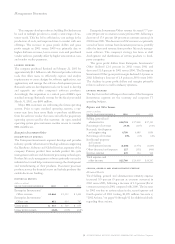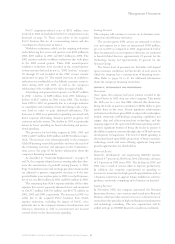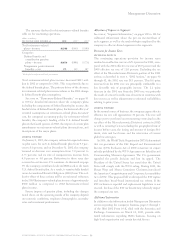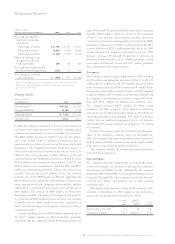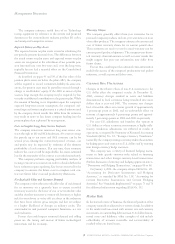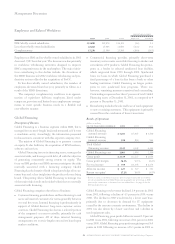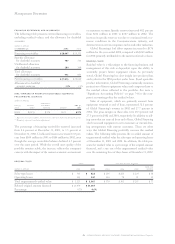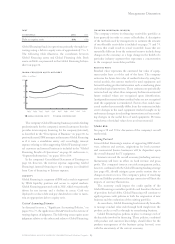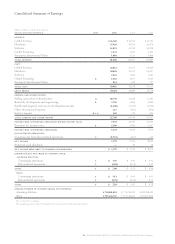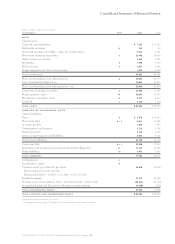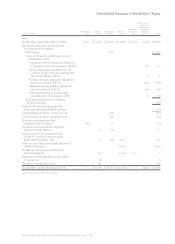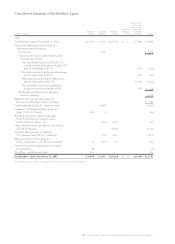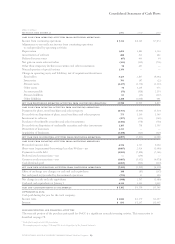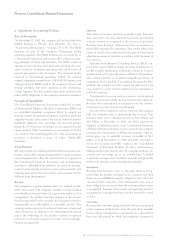IBM 2002 Annual Report Download - page 62
Download and view the complete annual report
Please find page 62 of the 2002 IBM annual report below. You can navigate through the pages in the report by either clicking on the pages listed below, or by using the keyword search tool below to find specific information within the annual report.
Management Discussion
60 international business machines corporation and Subsidiary Companies
Employees and Related Workforce
percentage changes
2002 2001 2000 2002-01 2001-00
IBM/wholly owned subsidiaries 315,889 319,876 316,303 (1.2) 1.1
Less-than-wholly owned subsidiaries 22,282 25,403 21,886 (12.3) 16.1
Complementary 17,250 21,300 25,500 (19.0) (16.5)
Employees at IBM and its wholly owned subsidiaries in 2002
decreased 3,987 from last year. The decrease was due primarily
to workforce rebalancing initiatives designed to improve
IBM’s competitiveness in the marketplace. The major initia-
tives contributing to this decline include: the divestiture of
the HDD business and 2002 workforce rebalancing and pro-
ductivity actions offset by the acquisition of PwCC.
In less-than-wholly owned subsidiaries, the number of
employees decreased from last year, primarily in China, as a
result of the HDD divestiture.
The company’s complementary workforce is an approxi-
mation of equivalent full-time employees hired under
temporary, part-time and limited-term employment arrange-
ments to meet specific business needs in a flexible and
cost-effective manner.
Global Financing
Description of Business
Global Financing is a business segment within IBM, but is
managed (on an arm’s-length basis) and measured as if it were
a standalone entity. Accordingly, the information presented
in this section is consistent with this separate company view.
The mission of Global Financing is to generate a return
on equity. It also facilitates the acquisition of IBM hardware,
software and services.
Global Financing invests in financing assets, manages the
associated risks, and leverages with debt
,
all with the objective
of generating consistently strong returns on equity. The
focus on IBM product and IBM customers mitigates the risks
normally associated with a financing company. Global
Financing has the benefit of both a deep knowledge of its cus-
tomer base and a clear insight into the products that are being
leased. This pairing allows Global Financing to manage two
of the major risks (credit and residual value) that are normally
associated with financing.
Global Financing comprises three lines of business:
■
Customer financing provides lease and loan financing to end
users and internal customers for terms generally between
two and five years. Internal financing is predominantly in
support of Global Services’ long-term customer service
contracts. Global Financing also factors a selected portion
of the company’s accounts receivable, primarily for cash
management purposes. All of these internal financing
arrangements are at arm’s-length rates and are based upon
market conditions.
■
Commercial financing provides primarily short-term
inventory and accounts receivable financing to dealers and
remarketers of IT products. Global Financing also partici-
pates as a lender in selected syndicated loan facilities
which originated from 1999 through 2001. Syndicated
loans are loans in which Global Financing purchased a
fixed percentage of a loan facility from a bank or other
lending institution. Global Financing no longer partici-
pates in new syndicated loan programs. There are,
however, remaining amounts committed and outstanding.
Outstandings represent less than 2 percent of total Global
Financing assets at December 31, 2002, as compared to 4
percent at December 31, 2001.
■
Remarketing includes the sale and lease of used equipment
to new or existing customers. This equipment is primarily
sourced from the conclusion of lease transactions.
Results of Operations
(dollars in millions)
for the year ended december 31: 2002 2001 2000
Global Financing
external revenue $«3,203 $«3,407 $«3,500
Global Financing
internal revenue «939 836 «944
Total Global
Financing revenue 4,142 4,243 4,444
Global Financing cost 1,803 «2,016 «2,390
Gross profit $«2,339 $«2,227 $«2,054
Gross profit margin 56.5% 52.5% 46.2%
Pre-tax income $««««955 $«1,143 $«1,176
After-tax income $««««627 $««««727 $««««763
Return on equity*«17.2% 18.4% 16.5%
*Return on equity is calculated using a five-point average of equity and an estimated
tax rate principally based on Global Financing’s geographic mix of earnings as IBM’s
provision for income taxes is determined on a consolidated basis. See page 89 for the
IBM consolidated tax rate.
Global Financing total revenue declined 2.4 percent in 2002
from 2001, following a decline of 4.5 percent in 2001 versus
2000. The decline in 2002 was driven by a lower asset base,
primarily due to decreases in demand for IT equipment
caused by the current economic environment. The decline in
2001 was also driven by a lower asset base and a decline in
used equipment sales.
Global Financing gross profit dollars increased 5.0 percent
in 2002 versus 2001, following an increase of 8.4 percent in 2001
versus 2000. Global Financing gross profit margin improved 4.0
points in 2002 following an increase of 6.3 points in 2001 as


